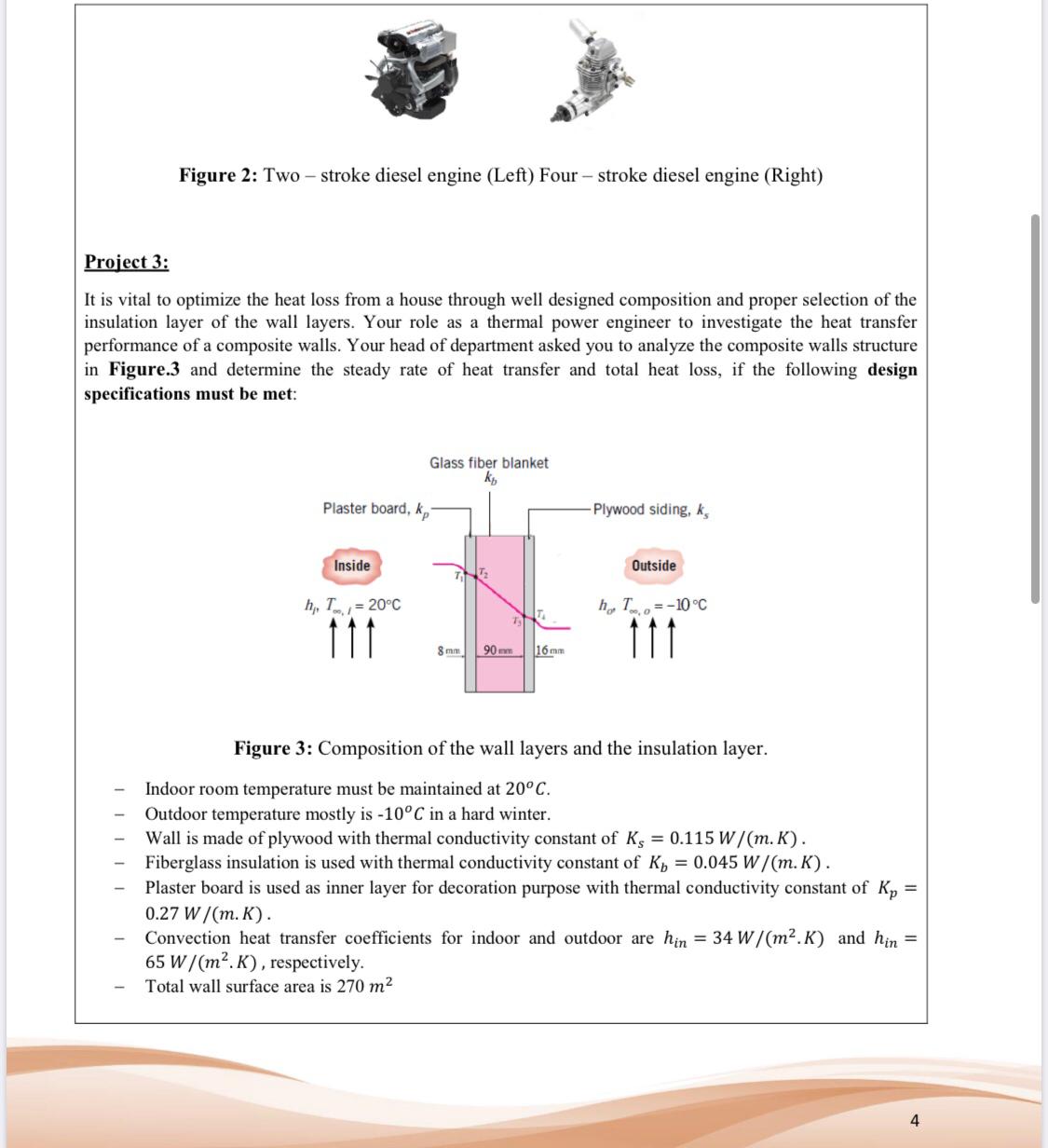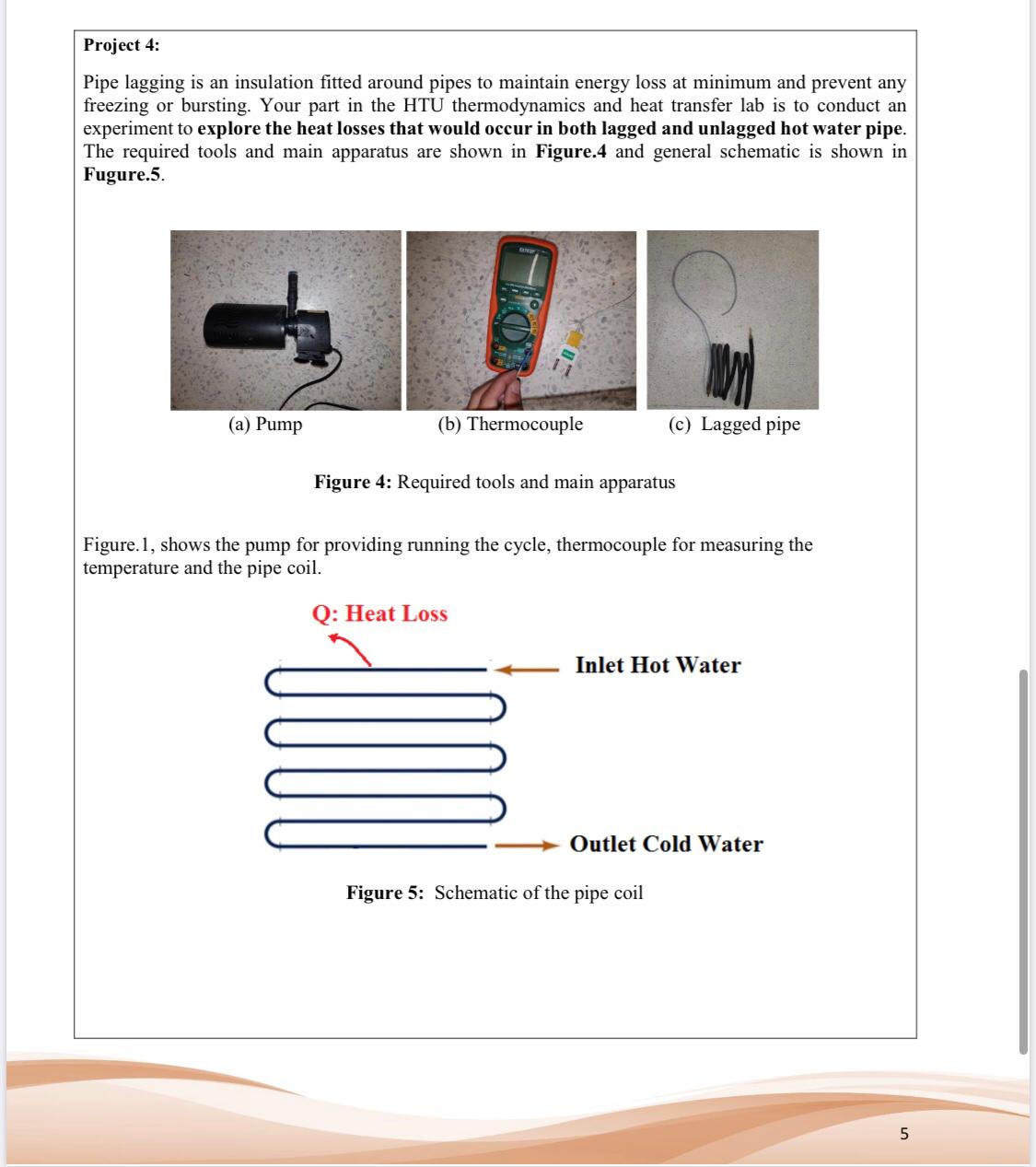
Elements Of Electromagnetics
7th Edition
ISBN: 9780190698614
Author: Sadiku, Matthew N. O.
Publisher: Oxford University Press
expand_more
expand_more
format_list_bulleted
Concept explainers
Question
The question in the picture

Transcribed Image Text:Figure 2: Two – stroke diesel engine (Left) Four – stroke diesel engine (Right)
Project 3:
It is vital to optimize the heat loss from a house through well designed composition and proper selection of the
insulation layer of the wall layers. Your role as a thermal power engineer to investigate the heat transfer
performance of a composite walls. Your head of department asked you to analyze the composite walls structure
in Figure.3 and determine the steady rate of heat transfer and total heat loss, if the following design
specifications must be met:
Glass fiber blanket
kp
Plaster board, k,
Plywood siding, k,
Outside
Inside
h, T=-10 °C
h, T = 20°C
11
16 mm
90 mm
8 mm
Figure 3: Composition of the wall layers and the insulation layer.
Indoor room temperature must be maintained at 20°C.
Outdoor temperature mostly is -10°C in a hard winter.
Wall is made of plywood with thermal conductivity constant of K, = 0.115 W/(m. K).
Fiberglass insulation is used with thermal conductivity constant of K, = 0.045 W/(m. K).
Plaster board is used as inner layer for decoration purpose with thermal conductivity constant of K,
0.27 W/(m. K).
Convection heat transfer coefficients for indoor and outdoor are hin = 34 W/(m2.K) and hin =
65 W/(m². K) , respectively.
Total wall surface area is 270 m2
4

Transcribed Image Text:Project 4:
Pipe lagging is an insulation fitted around pipes to maintain energy loss at minimum and prevent any
freezing or bursting. Your part in the HTU thermodynamics and heat transfer lab is to conduct an
experiment to explore the heat losses that would occur in both lagged and unlagged hot water pipe.
The required tools and main apparatus are shown in Figure.4 and general schematic is shown in
Fugure.5.
(c) Lagged pipe
(a) Pump
(b) Thermocouple
Figure 4: Required tools and main apparatus
Figure.1, shows the pump for providing running the cycle, thermocouple for measuring the
temperature and the pipe coil.
Q: Heat Loss
Inlet Hot Water
Outlet Cold Water
Figure 5: Schematic of the pipe coil
Expert Solution
This question has been solved!
Explore an expertly crafted, step-by-step solution for a thorough understanding of key concepts.
Step by stepSolved in 6 steps with 5 images

Knowledge Booster
Learn more about
Need a deep-dive on the concept behind this application? Look no further. Learn more about this topic, mechanical-engineering and related others by exploring similar questions and additional content below.Similar questions
- I am attaching both questions for 4 and 5 with the question in the image. thank you. NOTE : So the last person answered this question WITHOUT refencing the answer for whether question 4 or 5 answeres were given, so i am asking for question 5(or the answer for the question that was NOT solved because it was not referenced.) These were the following answers given to me from the last person on bartleby who answered my question without referencing whether it was the answer for question 4 or 5. 1 pass 2 fail 3 fail 4 passarrow_forwardGiven the top and front view create a section view.arrow_forwardLESSON: AUTODESK AUTOCAD Choose from the choices:arrow_forward
arrow_back_ios
arrow_forward_ios
Recommended textbooks for you
 Elements Of ElectromagneticsMechanical EngineeringISBN:9780190698614Author:Sadiku, Matthew N. O.Publisher:Oxford University Press
Elements Of ElectromagneticsMechanical EngineeringISBN:9780190698614Author:Sadiku, Matthew N. O.Publisher:Oxford University Press Mechanics of Materials (10th Edition)Mechanical EngineeringISBN:9780134319650Author:Russell C. HibbelerPublisher:PEARSON
Mechanics of Materials (10th Edition)Mechanical EngineeringISBN:9780134319650Author:Russell C. HibbelerPublisher:PEARSON Thermodynamics: An Engineering ApproachMechanical EngineeringISBN:9781259822674Author:Yunus A. Cengel Dr., Michael A. BolesPublisher:McGraw-Hill Education
Thermodynamics: An Engineering ApproachMechanical EngineeringISBN:9781259822674Author:Yunus A. Cengel Dr., Michael A. BolesPublisher:McGraw-Hill Education Control Systems EngineeringMechanical EngineeringISBN:9781118170519Author:Norman S. NisePublisher:WILEY
Control Systems EngineeringMechanical EngineeringISBN:9781118170519Author:Norman S. NisePublisher:WILEY Mechanics of Materials (MindTap Course List)Mechanical EngineeringISBN:9781337093347Author:Barry J. Goodno, James M. GerePublisher:Cengage Learning
Mechanics of Materials (MindTap Course List)Mechanical EngineeringISBN:9781337093347Author:Barry J. Goodno, James M. GerePublisher:Cengage Learning Engineering Mechanics: StaticsMechanical EngineeringISBN:9781118807330Author:James L. Meriam, L. G. Kraige, J. N. BoltonPublisher:WILEY
Engineering Mechanics: StaticsMechanical EngineeringISBN:9781118807330Author:James L. Meriam, L. G. Kraige, J. N. BoltonPublisher:WILEY

Elements Of Electromagnetics
Mechanical Engineering
ISBN:9780190698614
Author:Sadiku, Matthew N. O.
Publisher:Oxford University Press

Mechanics of Materials (10th Edition)
Mechanical Engineering
ISBN:9780134319650
Author:Russell C. Hibbeler
Publisher:PEARSON

Thermodynamics: An Engineering Approach
Mechanical Engineering
ISBN:9781259822674
Author:Yunus A. Cengel Dr., Michael A. Boles
Publisher:McGraw-Hill Education

Control Systems Engineering
Mechanical Engineering
ISBN:9781118170519
Author:Norman S. Nise
Publisher:WILEY

Mechanics of Materials (MindTap Course List)
Mechanical Engineering
ISBN:9781337093347
Author:Barry J. Goodno, James M. Gere
Publisher:Cengage Learning

Engineering Mechanics: Statics
Mechanical Engineering
ISBN:9781118807330
Author:James L. Meriam, L. G. Kraige, J. N. Bolton
Publisher:WILEY